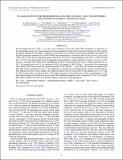PLASMA FLOWS IN THE HELIOSHEATH ALONG THE VOYAGER 1 AND 2 TRAJECTORIES DUE TO EFFECTS OF THE 11 YR SOLAR CYCLE
Author(s)
Provornikova, E.; Opher, M.; Izmodenov, V. V.; Toth, G.; Richardson, John D.
DownloadProvornikova-2014-PLASMA FLOWS IN THE.pdf (1.987Mb)
PUBLISHER_POLICY
Publisher Policy
Article is made available in accordance with the publisher's policy and may be subject to US copyright law. Please refer to the publisher's site for terms of use.
Terms of use
Metadata
Show full item recordAbstract
We investigate the role of the 11 yr solar cycle variations in the solar wind (SW) parameters on the flows in the heliosheath using a new three-dimensional time-dependent model of the interaction between the SW and the interstellar medium. For boundary conditions in the model we use realistic time and the latitudinal dependence of the SW parameters obtained from SOHO/SWAN and interplanetary scintillation data for the last two solar cycles (1990-2011). This data set generally agrees with the in situ Ulysses measurements from 1991 to 2009. For the first ~30 AU of the heliosheath the time-dependent model predicts constant radial flow speeds at Voyager 2 (V2), which is consistent with observations and different from the steady models that show a radial speed decrease of 30%. The model shows that V2 was immersed in SW with speeds of 500-550 km s[superscript –1] upstream of the termination shock before 2009 and in wind with upstream speeds of 450-500 km s[superscript –1] after 2009. The model also predicts that the radial velocity along the Voyager 1 (V1) trajectory is constant across the heliosheath, contrary to observations. This difference in observations implies that additional effects may be responsible for the different flows at V1 and V2. The model predicts meridional flows (VN) higher than those observed because of the strong bluntness of the heliosphere shape in the N direction in the model. The modeled tangential velocity component (VT) at V2 is smaller than observed. Both VN and VT essentially depend on the shape of the heliopause.
Date issued
2014-09Department
MIT Kavli Institute for Astrophysics and Space ResearchJournal
The Astrophysical Journal
Publisher
IOP Publishing
Citation
Provornikova, E., M. Opher, V. V. Izmodenov, J. D. Richardson, and G. Toth. “PLASMA FLOWS IN THE HELIOSHEATH ALONG THE VOYAGER 1 AND 2 TRAJECTORIES DUE TO EFFECTS OF THE 11 YR SOLAR CYCLE.” The Astrophysical Journal 794, no. 1 (September 22, 2014): 29. © 2014 The American Astronomical Society
Version: Final published version
ISSN
1538-4357
0004-637X